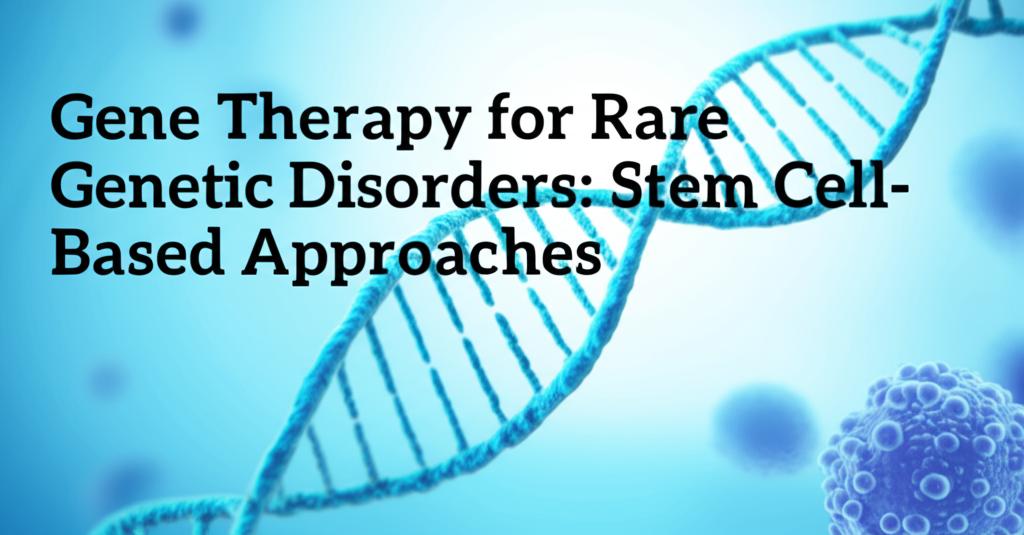For individuals and families grappling with rare genetic disorders, the prospect of gene therapy, particularly through stem cell-based approaches, offers a beacon of hope where previously few or no treatment options existed. These innovative therapies aim to rectify the underlying genetic flaws, potentially providing long-term, even curative, solutions.
The predominant method in stem cell gene therapy is an ex vivo (meaning "outside the body") process. This typically begins by collecting hematopoietic stem cells (HSCs) – the foundational cells that give rise to all blood and immune cells – from the patient. These HSCs are then taken to a lab where they are genetically engineered. This modification process often employs viral vectors, like lentiviruses or retroviruses, to deliver a healthy copy of the faulty gene into the DNA of the stem cells. Increasingly, sophisticated gene-editing tools such as CRISPR-Cas9 are being used for precise genetic correction. After successful modification and an increase in their numbers through cell culture, these engineered cells are infused back into the patient. Generally, before this infusion, the patient undergoes a "conditioning" treatment, often involving chemotherapy, to create space within the bone marrow for the modified stem cells to take hold and flourish. A notable clinical trial for Fanconi anemia, a rare blood disorder, has shown that autotransfusion of genetically corrected HSCs using a lentiviral vector to transfer the FANCA gene was successful in the majority of patients without the need for cytotoxic conditioning, marking a significant advancement.
Stem cells are uniquely suited for this therapeutic role due to their defining characteristics. Their ability to self-renew ensures that once the genetically corrected stem cells establish themselves, they can continuously produce healthy cells, potentially for the patient's entire life. Furthermore, their multipotency – the capacity to develop into various specialized cell types – makes them versatile for treating a broad spectrum of disorders, especially those affecting the blood and immune systems. For instance, corrected HSCs can generate healthy red blood cells, white blood cells, and platelets, thereby tackling the root cause of diseases such as beta-thalassemia, sickle cell disease, and various primary immunodeficiencies.
Significant advancements have been made in applying stem cell gene therapy to several rare genetic disorders. Conditions like Severe Combined Immunodeficiency (SCID), sometimes called "bubble boy disease," have seen high success rates, with many patients developing a functional immune system. For hemoglobinopathies like beta-thalassemia and sickle cell disease, gene therapies are increasingly becoming a clinical reality. Recent approvals of therapies such as Casgevy (exagamglogene autotemcel) – which uses CRISPR-Cas9 gene editing – and Lyfgenia (lovotibeglogene autotemcel) – which uses a lentiviral vector – for sickle cell disease highlight this progress, with Casgevy also approved for transfusion-dependent beta-thalassemia. As of early 2024, Casgevy has received approvals in the UK, Bahrain, the US (for sickle cell disease, followed by beta-thalassemia), Saudi Arabia, the European Union, and Canada. Other diseases, including metachromatic leukodystrophy (MLD) (with the approval of Libmeldy in Europe), Wiskott-Aldrich syndrome (WAS), and adrenoleukodystrophy (ALD), have also shown promising results in clinical trials using ex vivo HSC gene therapy. Indeed, as of 2024, there are 38 FDA-approved cell and gene therapy products.
Despite the remarkable progress, challenges persist. The high cost and complexity of these personalized treatments can limit patient access. The conditioning regimens patients undergo can have severe side effects. Long-term safety and effectiveness remain critical areas of ongoing observation, including the risk of insertional mutagenesis (where the gene-delivery vector inserts into an inappropriate location in the genome). However, newer vector designs and gene-editing technologies are being developed to minimize these risks. Scalable and cost-effective manufacturing of these cell products is another significant hurdle. Furthermore, delivering modified stem cells effectively to non-hematopoietic tissues and ensuring their engraftment for disorders affecting solid organs remains an area of intensive research. The development of in vivo gene therapy, where genes are corrected directly within the patient's body, including targeting HSCs in their natural bone marrow environment, represents a key future direction. The FDA has initiatives like the Rare Disease Innovation Hub and the START program to help accelerate the development of CGTs for rare diseases.
The field is in a state of rapid evolution. Innovations in viral vector technology, advancements in gene-editing tools like base and prime editing, and a growing understanding of stem cell biology are continuously improving these therapies. Researchers are also investigating induced pluripotent stem cells (iPSCs) as another potential source for generating patient-specific, genetically corrected cells for a broader range of conditions. The journey of stem cell-based gene therapy for rare genetic disorders is marked by substantial achievements, offering real hope for conditions previously considered untreatable. As research overcomes current limitations, these transformative treatments are expected to become more accessible, profoundly improving the lives of many patients and their families.

